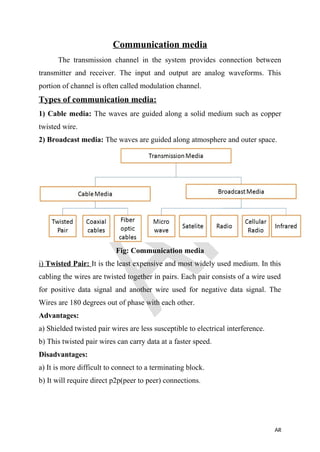
Types of Communication Media
- 1. Communication media The transmission channel in the system provides connection between transmitter and receiver. The input and output are analog waveforms. This portion of channel is often called modulation channel. Types of communication media: 1) Cable media: The waves are guided along a solid medium such as copper twisted wire. 2) Broadcast media: The waves are guided along atmosphere and outer space. Fig: Communication media i) Twisted Pair: It is the least expensive and most widely used medium. In this cabling the wires are twisted together in pairs. Each pair consists of a wire used for positive data signal and another wire used for negative data signal. The Wires are 180 degrees out of phase with each other. Advantages: a) Shielded twisted pair wires are less susceptible to electrical interference. b) This twisted pair wires can carry data at a faster speed. Disadvantages: a) It is more difficult to connect to a terminating block. b) It will require direct p2p(peer to peer) connections. AR
- 2. ii) Coaxial Cables: It consists of two conductors. The inner conductor is held inside an insulator with the other conductor woven around it providing a shield. An insulating protective coating called a jacket covers the outer conductor. Advantages: a) Greater bandwidth: Compared to twisted pair, coaxial provides greater bandwidth system wide, it supports a mixed range of services i.e. voice, data, video, multimedia etc. b) Coaxial cable shielding reduces noise and crosstalk. Disadvantages: a) Susceptible to damage from lightening strikes. b) High installation costs in the local environment. iii) Fiber optic cables: It consists of thin glass fibers that can carry information at frequencies in the visible light spectrum. The typical optical fiber consists of a very narrow strand of glass called the core. Around the core a concentric layer of glass called the cladding. Cladding has a protective coating of plastic called jacket. Optical fiber works on internal total reflection principle, the light pulses are kept within the fiber, propagating towards the far end with the speed of light. Advantages: a) Large capacity due to bandwidth b) No corrosion c) Smaller and lighter than copper wire Disadvantages: a) It will break if bend it too much b) Difficult to splice iv) Microwave Transmission: Microwave link can be one hop, consisting of one pair of antennas spaced as one or two kilometres apart or can be a backbone, including multiple hops, spanning several thousand kilometres. This transmission is relatively inexpensive as compared to fiber optics system. This AR
- 3. system permit data transmission rates of about 16 giga bits per second (giga=109 ). Advantages: a) No cabling needed between sites b) Wide bandwidth Disadvantages: a) Microwaves travel in a straight line, if the towers are too far apart, repeaters are needed periodically. v) Satelite Transmission: The major breakthrough in the communication is the satellite transmission. It relayed by satelite, starts with a transmitting antenna located with an uplink facility. Uplink satelite dishes are very large, as much as 9 to 12 meters in diameter. The increased diameter results in more accurate aiming and increased signal strength at the satelite. The uplink dish is pointed toward a specific satelite and the uplinked signals are transmitted with in a specific frequency range, so as to be received by one of the transponders tuned to that frequency range. The transponder ‘retransmits’ the signals back to earth but at a different frequency band (typically C-band (4 – 8 GHz) or Ku-band (12 -18 GHz) or both). The leg of the signal path from the satelite to the receiving earth station is called downlink. vi) Radio Transmission: Radio waves frequency Range: 10 KHz and 1GHz. These waves are easy to generate. They can travel long distances. They can penetrate buildings easily so they are widely used for communications both indoors and outdoors. These waves are Omni directional (can travel in all directions) so that the transmitter and receiver do not have to be carefully aligned physically. AR
- 4. Advantages: a) Can cover larger area and can penetrate walls. b) Current radio based products offer higher transmission rates (10 Mbit/s). Disadvantages: a) It is only permitted to certain frequency bands. b) Shielding is not simple. vii) Infrared wave Transmission: Infrared light is red light not visible to human eyes. Unguided infrared light (wave) are widely used for short range communication. The remote control used in TV, VCR, Stereos etc, all use infrared communication. Advantages: a) These waves need low power requirements and relatively directional. b) Low circuitry costs and these waves are easy to build. Disadvantages: a) Infrared waves do not pass through solid objects well. b) Performance drops off with longer distances. AR
